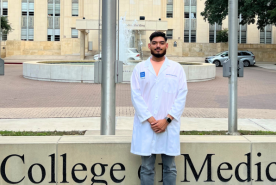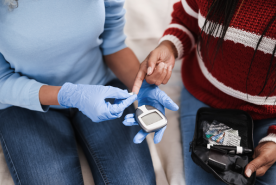Signs and symptoms
In the early stages, most people don’t have signs or symptoms. Kidney cancer is usually found by chance during an abdominal (belly) imaging test for other complaints. As the tumor grows, you may have:
- Blood in the urine
- Pain in the lower back
- A lump in the lower back or side of the waist
- Unexplained weight loss, night sweats, fever, or fatigue
Risk
A risk factor is anything that increases your chance of getting a disease. Some risk factors can be changed (smoking, as an example); but others cannot be changed (your gender or family history). Having a risk factor, or even several risk factors, does not mean you will get kidney cancer, but it may increase your risk.
- Risk factors for kidney cancer include:
- Smoking
- Being overweight (obese)
- High blood pressure
- Gender - about twice as many men as compared to women develop kidney cancer
- Being on dialysis treatment for advanced chronic kidney disease
- Family members with kidney cancer
- Long-term use of a pain-relieving drug called phenacetin
- Certain rare genetic diseases, such as von Hippel-Lindau disease, Birt Hogge Dube syndrome, and others
- History of long-term exposure to asbestos or cadmium
You may be able to lower your risk of developing kidney cancer by avoiding those risk factors that can be controlled. For example, stopping smoking may lower the risk, and controlling body weight and high blood pressure may help as well.
Kidney disease and kidney cancer
Studies show there is a link between kidney cancer and kidney disease.
Kidney cancer risk
Some studies show that people with kidney disease may have a higher risk for kidney cancer due to:
- Long-term dialysis: Some studies show that people on long-term dialysis have a 5-fold increased risk for kidney cancer. Experts believe this risk is due to kidney disease rather than dialysis.
- Immunosuppressant medicines: Some anti-rejection medicines that must be taken by kidney transplant recipients to prevent rejection can increase your risk for kidney cancer. However, taking your immunosuppressant medicine is important if you have a transplant. Without it, your body will reject your new kidney.
About one-third of the 300,000 kidney cancer survivors in the United States have or will develop kidney disease.[1], [2]
Kidney disease risk
- Surgery to remove an entire kidney (radical nephrectomy): Sometimes the entire kidney needs to be removed because the tumor is so large and most of the kidney has been destroyed. Your risk for kidney disease is higher if all (rather than part) of the kidney must be removed due to cancer. However, removing the whole kidney is often better for your survival if the tumor is large or centrally located. If a kidney tumor is small, it is better to undergo an operation to remove the tumor but not the entire kidney (partial nephrectomy). This approach decreases the chance of developing chronic kidney disease and associated problems with heart and blood vessel disease.
- Drugs to slow or stop cancer growth: Drugs that spread throughout the body to treat cancer cells, wherever they may be, are sometimes used to treat advanced kidney cancer. All cancer drugs have some side effects, but some can be toxic to the kidney (called nephrotoxic). The word “nephrotoxic” means it can damage your kidney function.
Remember, not everyone with kidney cancer will get kidney disease. Likewise, not everyone who has kidney disease or a transplant will get kidney cancer. Ask your doctor what you can do to lower your risk.
Kidney Cancer
Sign up for a deep dive into Kidney Cancer
Learn about Kidney Cancer, receive additional resources, and learn so much more.
Prevention
General prevention tips
- Don’t smoke
- Maintain a healthy weight
- Find out if you’re exposed to certain toxins at work or at home (such as cadmium, asbestos, and trichloroethylene, which may increase kidney cancer risk)
Take care of your kidneys
People with kidney disease may be at increased risk for kidney cancer:
- Ask your healthcare provider about 2 simple tests to find your kidney score:
- A blood test for kidney function called GFR
- A urine test for kidney damage called ACR
- Avoid prolonged use of non-steroidal anti-inflammatory drugs (NSAIDs) such as ibuprofen and naproxen
- Manage high blood pressure
- Manage your blood sugar if you have diabetes
Be aware of certain risk factors
- Family history of kidney cancer
- Certain diseases you may have been born with, such as von Hippel-Lindau disease
Types
Renal cell carcinoma
Renal cell carcinoma (RCC) is the most common type of kidney cancer in adults. RCC usually starts in the lining of tiny tubes in the kidney called renal tubules. RCC often stays in the kidney, but it can spread to other parts of the body, most often the bones, lungs, or brain.
Clear cell renal cell carcinoma
Clear cell renal cell carcinoma, also known as ccRCC or conventional renal cell carcinoma, is a the most common form of kidney cancer. Clear cell renal cell carcinoma is named after how the tumor looks under the microscope. The cells in the tumor look clear, like bubbles.
In adults, ccRCC makes up about 80% of all renal cell carcinoma cases. ccRCC is more common in adults than children. Renal cell carcinoma makes up 2% to 6% of childhood and young adult kidney cancer cases."
Rare types of kidney cancer
Rare kidney cancers occur most frequently in children, teenagers, and young adults.
Papillary renal cell carcinoma (PRCC)
- 15% of all renal cell carcinomas
- Tumor(s) located in the kidney tubes
- Type 1 PRCC is more common and grows slowly
- Type 2 PRCC is more aggressive and grows more quickly
Translocation renal cell carcinoma (TRCC)
- Accounts for 1% to 5% of all renal cell carcinomas and 20% of childhood caces
- Tumor(s) located in the kidney
- In children, TRCC usually grows slowly often without any symptoms
- In adults, TRCC tends to be agressive and fast-growing
Benign (non-cancerous) kidney tumors
Benign, or noncancerous kidney tumors grow in size but do not spread to other parts of the body and are not usually life-threatening. Surgical removal is the most common treatment and most tumors do you come back.
Papillary renal adenoma
- The most common benign kidney tumor
- Tumors are small, slow growing, often without any symptoms
- Usually an incidental finding on an imaging test done for a different readon
Oncocytoma
- Tumors start in the cells of the kidney collecting ducts and tumors can grow in one of both kidneys
- The tumors can grow to a large size about the These tumours can grow quite large, starting at just over an inch (walnut) and growing up to 4 inches (grapefruit)
Angiomyolipoma
- Benign fatty tumors can also be be due to overgrowth of blood vessel and smooth muscle tissue cells
- Tumors are non-cancerous, but they can become very large and destroy surrounding tissue
- Tumors that are over an inch and a half can cause internal bleeding
Diagnosis
Tests
Your doctor will diagnose kidney cancer by reviewing your medical history and doing a physical exam, along with blood and urine tests.
Imaging tests:
- Computed tomography (CT) scans use x-rays to make a complete picture of the kidneys and abdomen (belly). They can be done with or without a contrast dye. Small amounts of radiation are used. The CT scan often shows if a tumor appears cancerous or if it has spread beyond the kidney.
- Magnetic resonance imaging (MRI) scans make a complete picture of the kidneys and abdomen, but without radiation. They can be done with or without a contrast dye called gadolinium that should be avoided in people on dialysis or with very low kidney function.
- Ultrasound uses sound waves to give a complete picture of the kidneys and abdomen without radiation. It may be useful in helping to decide if a mass in the kidneys is a fluid-filled cyst or a solid tumor. This test is done without contrast dye.
A biopsy can be used in special cases, but is typically not recommended. A biopsy requires a very small piece of the kidney to be removed with a needle and then tested for cancer cells.
Who can help
Discuss all your treatment options with your medical team.
Your medical team may include the following specialists:
- Urologist (a surgical doctor who treats the urinary system)
- Oncologist (a doctor who specializes in cancer)
- Radiation oncologist (a doctor who treats cancer with radiation)
- Nephrologist (kidney doctor)
- Oncology nurse
- Social worker
- Other healthcare professionals
Make medical and health-related appointments as soon as possible. You may need several opinions about what treatment choices are best for you.
Treatment
The most common treatment for kidney cancer is with surgery to remove all or part of the kidney. However, your treatment will depend on the stage of your disease, your general health, your age, and other factors.
Surgery
Surgery is most common treatment for kidney cancer—most people with early stage cancer (stages 1, 2, and 3) can be cured with surgery.
Partial nephrectomy
In a partial nephrectomy, the tumor or the part of the kidney with the tumor is removed to leave behind as much of the kidney as possible
Radical nephrectomy
In a radical nephrectomy, the entire kidney is removed. If needed, the surrounding tissues and lymph nodes may also be removed.
Surgical approaches
Ask your doctor about the surgical approach that is best for you:
- Open (traditional surgery with a long incision)
- Laparoscopic (surgery done with a video camera and thin instruments for smaller incisions)
- Robotic (laparoscopic surgery done with the help of a robot)
Nonsurgical options
Thermal ablation
Thermal ablation kills the tumor by burning or freezing and is most often used for small tumors in people who are not good candidates for nephrectomy surgery
Active surveillance
Active surveillance is used if a small tumor is less than 4 centimeters (1.5 inches)
Chemotherapy and radiation
Forms of chemotherapy and radiation used in other forms of cancer are not usually effective treatments for most forms of kidney cancer
Advanced or recurrent kidney cancer treatment
For people with advanced kidney cancer that has spread to other parts of the body, treatment with a drug may be recommended along with surgery, or instead of surgery. Some of these drugs are given to you as a pill that you take by mouth; others are given as an injection. Much progress has been made in recent years, and people with advanced kidney cancer are living much longer than ten years ago.
- Medicine is often used for advanced kidney cancer that has spread to other parts of the body or where surgery cannot be done.
- Immunotherapy uses the body’s defense system (immune system) to stop or slow the growth of cancer cells
- Monoclonal antibodies attack a specific part of cancer cells
- Checkpoint inhibitors help the immune system recognize and attack cancer cells
- Vaccines give an overall boost to the immune system
- Immunotherapy uses the body’s defense system (immune system) to stop or slow the growth of cancer cells
- Anti-angiogenic therapies reduce the blood supply to a tumor to slow or stop its growth
- Targeted therapies directly inhibit the growth of the cancer
Nutrition
It is important to eat well for good nutrition during cancer treatment. Good nutrition means getting enough calories and nutrients to help prevent weight loss and regain strength. Patients who eat well often feel better and have more energy.
Some people find it hard to eat well during treatment. This is because their treatment may cause them to lose their appetite or have side effects like nausea, vomiting or mouth sores, which can make eating difficult. For some people, food tastes different. Others may not feel like eating because they feel uncomfortable or tired.
Physical Activity
Kidney cancer patients should be encouraged to be physically active before, during, and after treatments, except for some temporary limitations after surgery. Physical activity during and after treatment has been shown to decrease anxiety, depression, and fatigue, while improving physical function, and health-related quality of life. Physical activity helps prevent frailty by keeping bones and muscles strong for good mobility, as well as proper heart and lung function. Physical activity also helps to control other health issues such as obesity, diabetes, and high blood pressure, all of which can affect the kidneys. Being physically active covers a range of activities from walking and hiking to swimming and yoga, depending on each patient’s preferences, abilities, and health status.
The American Cancer Society Guideline on Diet and Activity for Cancer Survivors 2022 recommends that physical activity assessment and counseling begin as soon as possible after diagnosis, with the goal of helping patients prepare for treatments, tolerate and respond to treatments, and manage some cancer-related symptoms and treatment-related side effects.1 The American Cancer Society and American College of Sports Medicine recommend that cancer survivors do 150 minutes of moderate aerobic physical activity per week or 75 minutes of vigorous aerobic physical activity per week, along with strength training at least two days per week on all muscle groups.2
Alternative medicine
Complementary and alternative medicine (CAM) is the term for medical products and practices that are not part of standard medical care. Please discuss with your healthcare team any CAM products you are using to make sure they won't affect your treatment plan. These products are not tested for safety, and many can be harmful.
People with cancer may use CAM to:
- Help cope with the side effects of cancer treatments, such as nausea, pain, and fatigue
- Comfort themselves and ease the worries of cancer treatment and related stress
- Feel that they are doing something to help with their own care
- Try to treat or cure their cancer
Mind & Body Therapies
These combine mental focus, breathing, and body movements to help relax the body and mind. Some examples are:
- Meditation: Focused breathing or repetition of words or phrases to quiet the mind
- Biofeedback: Using simple machines, the patient learns how to affect certain body functions that are normally out of one's awareness (such as heart rate)
- Hypnosis: A state of relaxed and focused attention in which a person concentrates on a certain feeling, idea, or suggestion to aid in healing
- Yoga: Systems of stretches and poses, with special attention given to breathing
- Tai Chi: Involves slow, gentle movements with a focus on the breath and concentration
- Imagery: Imagining scenes, pictures, or experiences to help the body heal
- Creative outlets: Interests such as art, music, or dance
Biologically Based Practices
This type of CAM uses things found in nature. Some examples are:
- Vitamins and dietary supplements
- Botanicals, which are plants or parts of plants such as cannibis
- Herbs and spices such as turmeric or cinnamon
- Special foods or diets
Manipulative and Body-Based Practices
These are based on working with one or more parts of the body. Some examples are:
- Massage: The soft tissues of the body are kneaded, rubbed, tapped, and stroked
- Chiropractic therapy: A type of manipulation of the spine, joints, and skeletal system
- Reflexology: Using pressure points in the hands or feet to affect other parts of the body
Biofield Therapy
Biofield therapy, sometimes called energy medicine, involves the belief that the body has energy fields that can be used for healing and wellness. Therapists use pressure or move the body by placing their hands in or through these fields. Some examples are:
- Reiki: Balancing energy either from a distance or by placing hands on or near the patient
- Therapeutic touch: Moving hands over energy fields of the body
Whole Medical Systems
These are healing systems and beliefs that have evolved over time in different cultures and parts of the world. Some examples are:
- Ayurvedic medicine: A system from India in which the goal is to cleanse the body and restore balance to the body, mind, and spirit
- Traditional Chinese medicine: Based on the belief that health is a balance in the body of two forces called yin and yang
- Acupuncture is a common practice in Chinese medicine that involves stimulating certain points on the body to promote health, or to lessen disease symptoms and treatment side effects
- Homeopathy: Uses very small doses of substances to trigger the body to heal itself
- Naturopathic medicine: Uses various methods that help the body naturally heal itself. An example would be herbal treatment
Coping and support
Living with a serious illness is not easy. People with cancer and those who care about them face many problems and challenges. Coping with these problems often is easier when you have helpful information and support from friends and relatives. It also helps many people to meet in support groups to talk about their concerns with others who have or have had cancer. In support groups, patients share what they have learned about dealing with cancer and the effects of treatment.
Keep in mind that each person is different, and the same treatments and ways of dealing with cancer may not work for everyone. Always discuss the advice of friends and family with members of your healthcare team. Many cancer treatment centers have patient navigators who can help you:
- Know the right questions to ask your doctor and healthcare team
- Find more information about your condition and how to decide on the best treatment
- Make appointments and get the resources you need.
This support can reduce the stress of dealing with your care. Speaking with your doctor, healthcare team, and patient navigator about any concerns or questions is essential to getting the right information you need.
Resources
Find more information from the following organizations and programs.
National Cancer Institute
800.4.CANCER (800.422.6237) or www.cancer.gov
National Kidney and Urologic Disease Information Clearinghouse (NKUDIC), a service of the National Institute of Diabetes, Digestive and Kidney Diseases.
800.891.5390 or www.niddk.nih.gov
Kidney Cancer Association
www.kidneycancer.org
American Cancer Society
800.227.2345 or www.cancer.org
Questions for your doctor
You and your healthcare provider need to work together. Here are some questions to start the conversation.
- Do I have kidney cancer?
- Has my cancer spread beyond my kidneys?
- Can my kidney cancer be cured?
- What are my treatment options?
- How long will treatment last?
- Are there any risks or side effects associated with my treatment?
- What will my recovery be like?
- How long will it take for me to recover from treatment?
- What are the chances of cancer coming back?
- Should I also see a nephrologist (kidney doctor)?
- Will you be partnering with a nephrologist about my care?
- Should I get a second opinion?
- How much experience do you have treating this kind of cancer?
- Are there any clinical trials I should think about?
References
[1] What are the Key Statistics about Kidney Cancer. American Cancer Society. 2016; http://www.cancer.org/cancer/kidneycancer/detailedguide/kidney-cancer-adult-key-statistics. Accessed October 20, 2016.
[2] Chang A, Finelli A, Berns JS, Rosner M. Chronic kidney disease in patients with renal cell carcinoma. Adv Chronic Kidney Dis. Jan 2014;21(1):91-95.

















